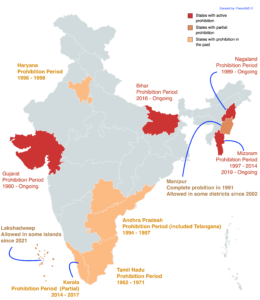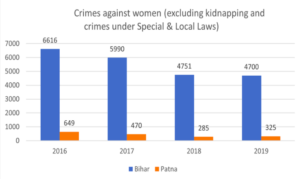ForumIAS announcing GS Foundation Program for UPSC CSE 2025-26 from 19 April. Click Here for more information.
ForumIAS Answer Writing Focus Group (AWFG) for Mains 2024 commencing from 24th June 2024. The Entrance Test for the program will be held on 28th April 2024 at 9 AM. To know more about the program visit: https://forumias.com/blog/awfg2024
Contents
- 1 Introduction
- 2 What has been the history of prohibition of liquor?
- 3 What is the current status of prohibition in the world?
- 4 What is the current status of prohibition of liquor in India?
- 5 What is the rationale behind prohibition of liquor?
- 6 What are the counter arguments given against prohibition of liquor?
- 7 Why have Governments been unable to effectively implement prohibition of liquor?
- 8 What corrective measures can be undertaken?
- 9 Conclusion
| For 7PM Editorial Archives click HERE → |
Introduction
In November 2021, the Chief Minister of Bihar and some key public servants renewed an oath to never consume liquor and pledged to undertake steps for the implementation of the liquor ban across the state. On that same day, the Director General of Police (DGP) Bihar administered an anti-liquor oath to personnel at the police headquarters in Patna to ensure full implementation of prohibition of liquor. According to various studies, the prohibition of liquor in Bihar has achieved only partial success in achieving its intended objectives. Ban on alcohol has become an electoral issue in recent times with various political parties and leaders advocating complete prohibition, especially to garner support of women voters. However the chequered success rate of such bans warrants a fundamental rethink of the approach.
This article will analyse the policy of alcohol prohibition, evaluating the benefits and side-effects of a total ban along with recommended remedial measures.
What has been the history of prohibition of liquor?
The term prohibition refers to legal prevention of the manufacture, storage, transportation, distribution, sale and consumption of alcoholic beverages with the aim of obtaining total abstinence through legal means. Prohibition and temperance have had an overlapping history in many countries since ancient times like in ancient China, Aztec civilisation and feudal Japanese society.
The anti-liquor movement in the West is nearly two-centuries old. An abstinence pledge was introduced by churches in the United States as early as 1800. One of the landmarks in the internationalisation of the movement was the organisation of the World Prohibition Conference in London, in 1909. It was instrumental in the formation of the International Prohibition Confederation, embracing the United States, the European countries and a few other industrialised countries of the world. Nationwide prohibition was enforced in the United States in 1920 (via 18th Amendment and National Prohibition Act). However, post 1933 a tilt towards liberalisation was seen as countries were unable to stop illicit liquor sale and were losing out on revenue. In 1933, the National Prohibition Act was repealed in the U.S.
What is the current status of prohibition in the world?
Most countries that introduced prohibition have withdrawn or liberalised the measure like the U.S, Japan, China etc. At present there is complete prohibition of liquor in 5countries in the Middle-East/North Africa which include Afghanistan, Libya, Saudi Arabia, Somalia and Sudan. Some other countries like Brunei Darussalam, Comoro, Iran, Kuwait, Maldives, Mauritania, Pakistan, Palestine, Syria and Yemen – prohibit alcohol for Muslim citizens only. The United Arab Emirates allows for some sale of alcohol except for the region of Sharjah.
What is the current status of prohibition of liquor in India?
Entry 51 in the State List makes ‘Alcohol for human consumption’ a subject matter of States. This provides States the power to make laws and charge duties on alcoholic liquors for human consumption. At present, ban exists in the States of Gujarat, Bihar, Nagaland and Mizoram; while partial bans are existent in Lakshadweep and Manipur. Some States like Haryana, Tamil Nadu, Kerala had tried to implement prohibition of liquor but abolished it due to ineffectiveness.
What is the rationale behind prohibition of liquor?
Health Benefits: Drinking liquor places an adverse impact on human health. It diminishes the utility and functioning of the vital organs of the body, especially liver and kidney. According to the WHO, the harmful use of alcohol is a causal factor in more than 200 disease and injury conditions and globally 3 million death occur every year due to harmful use of alcohol (5.3% of all deaths).
Source: WHO Global Status Report on Alcohol and Health, 2018
Constitutional Obligation: Article 47 of the Constitution directs the State to take measures to raise the level of nutrition and the standard of living and to improve public health. Further the State shall endeavour to bring about prohibition of the consumption of intoxicating drinks and of drugs which are injurious to health.
Curb Gender Violence: Several studies have pointed out direct correlation between consumption of alcohol and gender violence including in the domestic setting. A study in Bihar had found that 40% of ever-married women aged between 15 and 49 reported that they experienced physical, sexual or emotional violence by their husbands during the previous 12 months. Proponents argue that prohibition of liquor has potential to bring down the levels of intimate partner violence. A study conducted in Bihar has supported the argument e.g., there has been 28.9% reduction in crimes against women in Bihar between 2016-2019 (after prohibition)
Source: Sexual Violence Research Initiative
Reduction in Crime: A reduction in alcohol consumption is also desired to reduce crime in the society as intoxication impairs an individual’s ability to distinguish between right or wrong. A report by the Asian Development Research Institute (ADRI) on prohibition in Bihar noted there was a 66.6% dip in cases of kidnapping for ransom, followed by 28.3% dip in murder cases and 2.3% in dacoity.
Economic Stress: Addiction to alcohol creates severe hardships especially for poor families as the male members tend to spend more on alcohol due to their excessive addiction. This in turn reduces the budget for spending on essential items and in many cases pushes the family into borrowings. The 1992 Anti-arrack movement that took place in Andhra Pradesh is a testimony to this. The money saved due to prohibition of liquor is used more productively e.g., the ADRI study pointed out that 19% of households acquired new assets from the money they earlier splurged on alcohol.
What are the counter arguments given against prohibition of liquor?
Right to Choice: A total ban goes against an individual’s right to choice and undermines a person’s freedom.
Economic Loss: The Indian Made Foreign Liquors (IMFL) industry contributes over INR 1 lakh crore in taxes every year. It supports the livelihood of 35 lakh farming families and provides direct and indirect employment to lakhs of workers employed in the industry. It also supports hundreds of ancillary industries in glass, tin, plastic and paper with a turnover of Rs 6,000-7,000 crore.
Moreover complete prohibition has a negative impact on tourism and hospitality sectors.
Bootlegging: Failure of effective implementation gives rise to bootlegging (the illegal production, transport and sale of liquor). Liquor mafias emerge which keeps on supplying the illicit liquor (with no quality checks) to the masses. This defeats the purpose of prohibition of liquor, and gives rise to organized crime as well.
Health impacts: Many people lose their lives by consuming poor quality illicit liquor (hooch). News reports indicate that as many as 60 people have died after consuming hooch in Bihar since November 2021.
Populist measure: Critics argue that Alcohol prohibition is merely used as a political card, especially to woo women voters. However it doesn’t solve their problems as people addicted to alcohol end up consuming hooch and other illegal alcoholic substances whose impact is similar or even worse than legally manufactured alcohol.
Judicial Burden: It creates tremendous burden on the courts and enhances the pendency of cases e.g., till February 2020, around 2.14 lakh cases were registered under Bihar Prohibition and Excise Act, 2016.
Why have Governments been unable to effectively implement prohibition of liquor?
Prevalence of Corruption: Generally, the local officials form a nexus with the liquor mafia and overlook the underground activities. This police-mafia nexus problem is not limited to India, this had been evident in the US as well during the period of prohibition (1920-33).
Dynamic Modus Operandi: The modus operandi of unlawful players keeps on changing from time to time. The places of production, mode of transportation, and code languages keep on changing which are very difficult to detect.
Support by Neighbouring regions: The liquor gets smuggled from the neighbouring states e.g., Daman (neighbouring Gujarat) has a per capita consumption of 56 litres per annum against the national average of just 4.3 litres per annum. The data show it plays a key role in meeting the demand of Gujarat.
Huge Supply of Workforce: There is a huge supply of unemployed youth who want to make quick money by smuggling illicit liquor. The youth who get caught are quickly replaced. Further bail can be easily obtained due to nexus with officials.
High Degree of Addiction: The ban doesn’t reduce the demand of alcohol rather intensifies it. People are willing to risk their lives and drink illicit liquor just to satisfy their addiction. In the US, the prohibition indirectly increased the use of drugs and other harmful substances among those who could not get hold of alcohol.
What corrective measures can be undertaken?
The principal reason why many prohibition strategy fail is because they seem to be based on the simplistic assumption that cutting off the supply impacts effective demand for alcohol. So there is a need to adopt alternative strategies.
First, Policy makers should focus on framing laws which encourage responsible behaviour and compliance.
Second, Drinking age should be made uniform across the country and the rules should be strictly implemented.
Third, Tough laws should be made and implemented against drunken behaviour in public, domestic violence under alcohol influence, and drinking and driving.
Fourth, Governments should set aside part of revenue earned from alcohol for social education and de-addiction. Community based approach should be adopted to tackle the problem of alcoholism.
Conclusion
Prohibition of liquor is not the ideal solution to check overuse of alcohol and curbing its harmful impact. On the contrary, multiple studies have shown that prohibition proves to be counter productive. The focus of the policy-makers should be on promoting moderation and temperance.
Source: Mint







